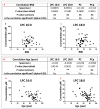Identification of Lipid Biomarkers for Chronic Joint Pain Associated with Different Joint Diseases
- PMID: 36830710
- PMCID: PMC9953120
- DOI: 10.3390/biom13020342
Identification of Lipid Biomarkers for Chronic Joint Pain Associated with Different Joint Diseases
Abstract
Lipids, especially lysophosphatidylcholine LPC16:0, have been shown to be involved in chronic joint pain through the activation of acid-sensing ion channels (ASIC3). The aim of the present study was to investigate the lipid contents of the synovial fluids from controls and patients suffering from chronic joint pain in order to identify characteristic lipid signatures associated with specific joint diseases. For this purpose, lipids were extracted from the synovial fluids and analyzed by mass spectrometry. Lipidomic analyses identified certain choline-containing lipid classes and molecular species as biomarkers of chronic joint pain, regardless of the pathology, with significantly higher levels detected in the patient samples. Moreover, correlations were observed between certain lipid levels and the type of joint pathologies. Interestingly, LPC16:0 levels appeared to correlate with the metabolic status of patients while other choline-containing lipids were more specifically associated with the inflammatory state. Overall, these data point at selective lipid species in synovial fluid as being strong predictors of specific joint pathologies which could help in the selection of the most adapted treatment.
Trial registration: ClinicalTrials.gov NCT01867840.
Keywords: chronic joint pain; inflammation; lipidomics; metabolic status; synovial fluid.
Conflict of interest statement
The authors declare that they have no conflict of interest.
Figures







Similar articles
-
Lysophosphatidylcholine 16:0 mediates chronic joint pain associated to rheumatic diseases through acid-sensing ion channel 3.Pain. 2022 Oct 1;163(10):1999-2013. doi: 10.1097/j.pain.0000000000002596. Epub 2022 Jan 27. Pain. 2022. PMID: 35086123 Free PMC article.
-
What is the performance of novel synovial biomarkers for detecting periprosthetic joint infection in the presence of inflammatory joint disease?Bone Joint J. 2021 Jan;103-B(1):32-38. doi: 10.1302/0301-620X.103B1.BJJ-2019-1479.R3. Bone Joint J. 2021. PMID: 33380185
-
Arthrogenic lameness of the fetlock: synovial fluid markers of inflammation and cartilage turnover in relation to clinical joint pain.Equine Vet J. 2006 Jul;38(4):305-11. doi: 10.2746/042516406777749236. Equine Vet J. 2006. PMID: 16866196
-
Synovial fluid lipid abnormalities in various disease states: review and classification.Semin Arthritis Rheum. 1987 Feb;16(3):222-30. doi: 10.1016/0049-0172(87)90024-2. Semin Arthritis Rheum. 1987. PMID: 3547659 Review.
-
Synovial fluid analysis.Best Pract Res Clin Rheumatol. 2005 Jun;19(3):371-86. doi: 10.1016/j.berh.2005.01.004. Best Pract Res Clin Rheumatol. 2005. PMID: 15939364 Review.
Cited by
-
Ion channels in osteoarthritis: emerging roles and potential targets.Nat Rev Rheumatol. 2024 Sep;20(9):545-564. doi: 10.1038/s41584-024-01146-0. Epub 2024 Aug 9. Nat Rev Rheumatol. 2024. PMID: 39122910 Free PMC article. Review.
-
Phospholipids and Sphingolipids in Osteoarthritis.Biomolecules. 2025 Feb 8;15(2):250. doi: 10.3390/biom15020250. Biomolecules. 2025. PMID: 40001553 Free PMC article. Review.
-
Functional determinants of lysophospholipid- and voltage-dependent regulation of TRPC5 channel.Cell Mol Life Sci. 2024 Aug 29;81(1):374. doi: 10.1007/s00018-024-05417-7. Cell Mol Life Sci. 2024. PMID: 39210039 Free PMC article.
References
-
- Wittenauer R., Smith L., Aden K. Background Paper 6.12 Osteoarthritis. Backgr. Pap. 2004;31:78314428.
-
- Jacquot F., Khoury S., Labrum B., Delanoe K., Pidoux L., Barbier J., Delay L., Bayle A., Aissouni Y., Barriere D.A., et al. Lysophosphatidylcholine 16: 0 Mediates Chronic Joint Pain Associated to Rheumatic Diseases through Acid-Sensing Ion Channel 3. Pain. 2022;163:1999–2013. doi: 10.1097/j.pain.0000000000002596. - DOI - PMC - PubMed
Publication types
MeSH terms
Substances
Associated data
Grants and funding
LinkOut - more resources
Full Text Sources
Medical

